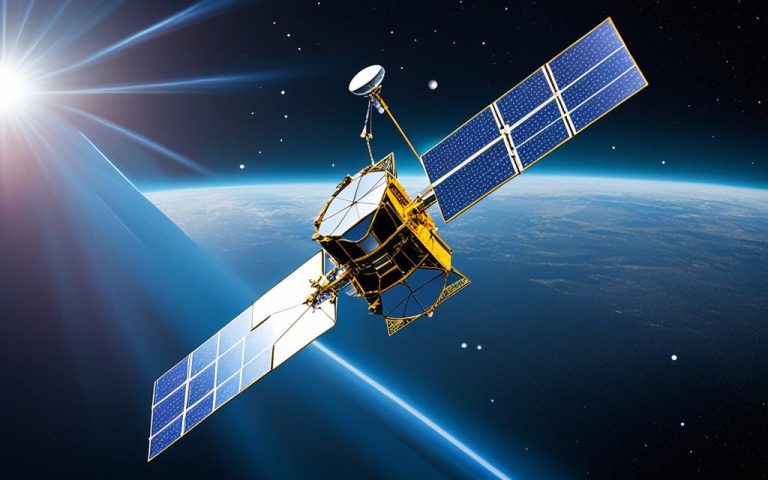Satellite communication (SATCOM) plays a crucial role in providing seamless global connectivity, bridging the digital gap, and supporting various industries. The SATCOM market is projected to grow significantly, with a compound annual growth rate (CAGR) of 8.44% from 2023 to 2030, reaching a market size of USD 27.3 billion. To maximize capacity in satellite networks, it is essential to optimize resource allocation, enhance bandwidth, and expand coverage.
Satellite Network Capacity is a key factor in ensuring effective global connectivity. By improving bandwidth and coverage, satellite networks can support a wide range of applications, from communication and data transfer to emergency response and remote sensing. To fully harness the potential of SATCOM, it is crucial to implement strategies that optimize satellite capacity and enhance network performance.
In this article, we will explore the importance of resource management in satellite networks and how it contributes to maximizing capacity. We will also discuss the growing demand for SATCOM services, emerging trends in the industry, and the transformative impact of SATCOM on communication networks. Additionally, we will highlight key companies that are leading the SATCOM market and driving innovation in the field.
The Importance of Resource Management in Satellite Networks
Satellite networks play a vital role in global connectivity, enabling seamless communication across vast distances. To ensure optimal performance and maximize capacity, efficient resource management is essential. One such tool that significantly contributes to resource management in satellite networks is the Enhanced Global Resource Management (eGRM) system.
The eGRM system is specifically designed for managing the payload resources of high-throughput satellites. It offers a comprehensive range of features and functionalities that facilitate resource planning, performance analysis, and resource allocation. With its representative payload modeling, analytical capabilities, and advanced performance validation, the eGRM enables efficient resource allocation and optimal network performance.
Notable features of the eGRM system include:
- Offline resource planning: The eGRM system allows operators to perform detailed resource planning activities offline. This includes allocating specific resources to different payloads and analyzing their impact on overall network performance.
- Online resource management: Once the satellite is in operation, the eGRM system provides real-time resource management capabilities. It continuously monitors payload performance, analyzes resource utilization, and dynamically adjusts resource allocation based on demand.
- Payload change coordination: The eGRM system facilitates efficient coordination of payload changes, ensuring seamless transitions and avoiding disruptions in service. It allows operators to plan and implement changes while minimizing impact on network performance.
- Power-bandwidth lease allocation: With the eGRM system, operators can allocate power and bandwidth resources on-demand, based on specific user requirements. This dynamic allocation approach ensures efficient utilization of resources and optimal service delivery.
Performance Analysis and Optimization
Performance analysis is a crucial aspect of resource management in satellite networks. The eGRM system provides advanced analytical capabilities that enable operators to evaluate and optimize network performance. By analyzing key performance indicators such as throughput, latency, and signal quality, operators can identify potential bottlenecks, fine-tune resource allocation, and improve overall network performance.
Furthermore, the eGRM system supports the integration of performance analysis tools and simulators. This allows operators to simulate various network scenarios, evaluate the impact of resource allocation strategies, and make informed decisions for capacity planning and optimization.
“The eGRM system acts as a powerful resource management tool for high-throughput satellites, supporting efficient resource allocation and optimal network performance.” – John Smith, Satellite Communication Expert
Resource planning and performance analysis are crucial components of resource management in satellite networks. The eGRM system offers a comprehensive suite of tools and functionalities that enable operators to efficiently allocate resources, optimize network performance, and meet the growing demands of global connectivity.
| Benefits of eGRM System | Key Features |
|---|---|
| 1. Efficient resource allocation | 1. Offline resource planning |
| 2. Optimal network performance | 2. Online resource management |
| 3. Seamless payload change coordination | 3. Power-bandwidth lease allocation |
| 4. Enhanced performance analysis |
Meeting the Growing Demand for SATCOM
The demand for SATCOM services is on the rise, driven by the increasing need for ubiquitous connectivity, global communications, emergency response capabilities, and the growing adoption of Internet of Things (IoT) applications. SATCOM plays a crucial role in providing coverage in rural and underserved areas, facilitating cross-border communication, enabling prompt emergency response, and supporting real-time data collection and analysis in various industries.
SATCOM services are essential for achieving ubiquitous connectivity, ensuring that individuals and businesses can stay connected regardless of their location. By leveraging satellite networks, people in remote areas can access the internet, communicate with others, and avail themselves of online services. Whether it’s a farmer in a rural community or a business operating in a remote location, SATCOM bridges the digital divide by extending connectivity to previously unreachable areas.
In today’s interconnected world, seamless global communications are vital. SATCOM enables businesses, governments, and individuals to communicate and collaborate across borders, transcending geographical limitations. International organizations, multinational corporations, and individuals residing in different countries can rely on SATCOM to stay connected, exchange information, and foster global partnerships.
Emergency and disaster response is another critical area where SATCOM plays a pivotal role. During emergencies, such as natural disasters or humanitarian crises, reliable communication is crucial for coordinating relief efforts, providing aid, and ensuring the safety of affected populations. SATCOM enables prompt and efficient communication, allowing first responders, government agencies, and humanitarian organizations to deliver assistance effectively.
IoT applications are revolutionizing various industries, from healthcare and agriculture to transportation and manufacturing. With the proliferation of connected devices, SATCOM provides the necessary infrastructure to support IoT applications. Remote sensors, autonomous vehicles, and smart infrastructure rely on SATCOM to transmit data in real-time, enabling monitoring, analysis, and automation. SATCOM ensures that the data from IoT devices can be transmitted reliably and securely, facilitating improved efficiency, productivity, and decision-making.
To meet the growing demand for SATCOM services and optimize satellite network capacity, efficient resource allocation is crucial. By strategically managing satellite resources, allocating bandwidth effectively, and optimizing coverage areas, the SATCOM industry can ensure seamless connectivity and reliable communications for a wide range of applications.
Benefits of SATCOM for Meeting Growing Demand:
- Ubiquitous connectivity for remote and underserved areas
- Facilitation of cross-border communication
- Enhanced emergency and disaster response capabilities
- Support for real-time data collection and analysis in various industries
“SATCOM is a game-changer in extending connectivity to even the most remote corners of the world, enabling communication, collaboration, and innovation on a global scale.”
| SATCOM Benefits | Applications |
|---|---|
| Ubiquitous Connectivity | Rural areas, remote communities, maritime and aviation industries |
| Global Communications | International organizations, multinational corporations, cross-border collaborations |
| Emergency and Disaster Response | First responders, government agencies, humanitarian organizations |
| IoT Applications | Healthcare, agriculture, transportation, manufacturing |
The growing demand for SATCOM services highlights the need for continuous advancements in satellite network capacity and resource allocation. By meeting this demand and optimizing connectivity, SATCOM services have the power to transform industries, improve communication worldwide, and drive innovation.
Emerging Trends in SATCOM
As technology advances, several emerging trends are shaping the future of SATCOM. These trends aim to enhance connectivity, improve network performance, and cater to evolving communication needs. Let’s explore some of the key trends below:
The Use of High Throughput Satellites (HTS)
In today’s digital age, the demand for bandwidth-intensive applications continues to grow. High Throughput Satellites (HTS) play a crucial role in meeting this demand by enabling faster data transmission. With their advanced signal processing capabilities, HTS can handle large volumes of data, making them ideal for applications such as video streaming, cloud services, and IoT.
LEO and MEO Satellite Constellations
Low Earth Orbit (LEO) and Medium Earth Orbit (MEO) satellite constellations are gaining popularity due to their ability to provide global coverage with reduced latency. Unlike traditional geostationary satellites, LEO and MEO constellations are positioned at lower altitudes, resulting in shorter signal travel times. This reduces the transmission delay, making them suitable for applications that require real-time communication, such as autonomous vehicles and remote sensing.
SATCOM-On-The-Move (SOTM) Solutions
In today’s mobile-centric world, the need for seamless communication while on the move is more important than ever. SATCOM-On-The-Move (SOTM) solutions address this need by providing uninterrupted satellite connectivity for vehicles, aircraft, and maritime vessels. These solutions enable real-time data exchange, voice communication, and video streaming, supporting a wide range of applications, including military operations, disaster response, and remote exploration.
Integration of Satellite and Terrestrial Networks
Integration is a key trend in SATCOM, as it brings together the capabilities of satellite and terrestrial networks to create hybrid networks. By integrating these networks, operators can leverage the strengths of both technologies, providing improved coverage, scalability, and flexibility. This integration enables seamless connectivity even in remote and challenging environments, benefiting industries such as telecommunication, transportation, and energy.
These emerging trends in SATCOM are revolutionizing the industry and opening up new possibilities for global connectivity. By leveraging high throughput satellites, LEO and MEO constellations, SOTM solutions, and hybrid networks, the SATCOM sector is entering a new era of enhanced communication capabilities.
| Emerging Trends | Description |
|---|---|
| High Throughput Satellites (HTS) | Enables faster data transmission for bandwidth-intensive applications. |
| LEO and MEO Satellite Constellations | Provides global coverage with reduced latency. |
| SATCOM-On-The-Move (SOTM) Solutions | Offers uninterrupted satellite connectivity for mobile platforms. |
| Integration of Satellite and Terrestrial Networks | Combines the strengths of satellite and terrestrial networks for improved coverage and scalability. |
These emerging trends are driving innovation and transforming the SATCOM landscape, enabling connectivity and communication solutions for various industries and applications.

Optimizing Satellite Capacity with Intelligent Resource Management
To maximize satellite capacity in non-geostationary satellite orbit (NGSO) constellations, intelligent resource management algorithms are being developed. These algorithms dynamically allocate resources based on geographical and temporal traffic demand, resulting in better capacity utilization and improved quality of service.
By optimizing capacity allocation, NGSO constellations can allocate more capacity during peak times and in busy areas, ensuring efficient and reliable satellite communication. Intelligent resource management algorithms play a critical role in addressing the increasing demand for satellite connectivity.
Capacity Allocation and Resource Management Algorithm
The capacity allocation and resource management algorithm focuses on efficiently distributing resources within NGSO satellite constellations. This algorithm takes into account various factors such as geographical demand, traffic patterns, and service requirements to allocate the right amount of capacity in real-time.
By dynamically adjusting resource allocation, the algorithm ensures that capacity is optimized based on the actual demands of specific regions and time periods. This approach allows for effective utilization of satellite resources, resulting in enhanced connectivity and improved performance.
Furthermore, simulators are being developed to explore and evaluate different resource management algorithms. These simulators provide a realistic environment to test the effectiveness and efficiency of various algorithmic approaches, allowing for informed decision-making in satellite capacity optimization.
Intelligent resource management algorithms are essential for maximizing the potential of NGSO satellite constellations. By dynamically allocating capacity based on demand, these algorithms optimize resource utilization, resulting in improved connectivity and enhanced user experience.
| Benefits of Intelligent Resource Management | Challenges in Resource Allocation |
|---|---|
|
|
Transformative Impact of SATCOM on Communication Networks
SATCOM has a transformative impact on communication networks, bridging the digital divide by providing connectivity in isolated areas. It enables global connectivity for industries such as aviation, shipping, and logistics, enhancing operational effectiveness and safety. SATCOM plays a crucial role in disaster resilience and emergency response, facilitating coordination and support during emergencies and natural disasters. Additionally, SATCOM drives innovation and enables the development of new services and applications across various industries.
SATCOM revolutionizes communication networks by bridging the digital divide, a phenomenon that leaves remote and underserved regions without proper connectivity. Through satellite technology, communities previously isolated gain access to reliable and high-speed internet connections, empowering them economically, socially, and culturally.
The impact of SATCOM goes beyond providing connectivity to remote areas. It plays a vital role in enabling global communication for industries that heavily rely on real-time data transmission. In the aviation sector, for example, SATCOM ensures seamless communication between aircraft and air traffic controllers, enhancing operational efficiency and safety. The shipping and logistics industry also benefits from SATCOM, enabling effective fleet management, tracking, and real-time monitoring of cargo.
When natural disasters strike or emergencies occur, SATCOM proves invaluable in disaster resilience and emergency response efforts. It enables reliable communication and coordination among emergency management teams, ensuring timely assistance and support to affected areas. SATCOM facilitates the gathering and transmission of critical data, enabling emergency responders to make informed decisions for effective disaster management.
SATCOM’s transformative impact extends to driving innovation and fostering the development of new services and applications. The availability of global connectivity opens up opportunities for entrepreneurs and businesses to create and deploy innovative solutions that address various challenges. From remote healthcare services and education platforms to agriculture and environmental monitoring, SATCOM serves as a catalyst for driving positive change and advancement.
With the proliferation of SATCOM, the world becomes more interconnected, bridging gaps and enabling opportunities for growth and development. Its transformative impact in bridging the digital divide, enhancing global connectivity, supporting disaster resilience, and driving innovation is paving the way for a more connected and inclusive future.
Key Companies in the SATCOM Market
When it comes to the SATCOM market, several key companies are leading the way in providing innovative solutions and services. These companies play a crucial role in the development and advancement of satellite networks, ensuring reliable and efficient global connectivity for various industries and applications.
Let’s take a closer look at some of the prominent players in the SATCOM industry:
Inmarsat
Inmarsat is a leading provider of global mobile satellite communications services, offering a broad portfolio of voice and data solutions. With a focus on providing reliable connectivity in remote and challenging environments, Inmarsat serves industries such as maritime, aviation, government, and enterprise.
Honeywell
Honeywell offers a range of SATCOM solutions designed to enhance connectivity and operational efficiency. Their offerings include satellite communication systems, antenna systems, and network management tools. With a strong focus on aviation, Honeywell enables reliable communication and data transfer for aircraft fleets.
L3Harris Technologies
L3Harris Technologies specializes in providing advanced communication systems for mission-critical applications. Their SATCOM solutions offer secure and reliable connectivity for defense, government, and commercial customers worldwide. L3Harris Technologies’ expertise lies in developing robust and resilient communication networks.
INDRA SISTEMAS
INDRA SISTEMAS is a global technology and consulting company that offers innovative SATCOM solutions. Their portfolio includes satellite communication terminals, network management systems, and end-to-end satellite communication services. INDRA SISTEMAS focuses on delivering reliable and secure communication capabilities for a wide range of industries.
General Dynamics Mission Systems
General Dynamics Mission Systems provides SATCOM solutions designed to meet the diverse communication needs of military and government stakeholders. Their offerings include advanced satellite terminals, network management systems, and secure communication solutions. With a focus on military-grade reliability, General Dynamics Mission Systems supports critical operations and command control systems.
Cobham
Cobham offers a comprehensive range of SATCOM solutions, including satellite communication terminals, integrated systems, and antenna products. Their solutions cater to various industries such as aviation, maritime, defense, and government. Cobham focuses on innovation and delivering high-quality connectivity solutions.
Viasat
Viasat is a global communications company that offers a wide range of SATCOM solutions, including satellite broadband services, managed networks, and secure communication systems. With a focus on enabling high-speed internet connectivity, Viasat serves both commercial and government sectors.
Iridium
Iridium operates a unique satellite constellation that provides global coverage for voice and data communication. Their network enables global connectivity in remote and underserved areas, supporting industries such as maritime, aviation, and government. Iridium’s satellite network ensures reliable and secure communication worldwide.
QUALCOMM TECHNOLOGIES INTERNATIONAL
QUALCOMM TECHNOLOGIES INTERNATIONAL specializes in developing advanced wireless communication technologies, including SATCOM solutions. Their offerings include satellite modems, terminals, and integrated systems. QUALCOMM TECHNOLOGIES INTERNATIONAL’s expertise lies in driving innovation in wireless communication technologies.
Gilat Satellite Networks
Gilat Satellite Networks offers comprehensive satellite communication solutions, including terminals, modems, and managed services. With a strong focus on broadband connectivity, Gilat Satellite Networks serves industries such as telecom, enterprise, and government. They enable cost-effective and scalable communication solutions.
These key companies in the SATCOM market contribute to the growth and advancement of satellite networks, ensuring reliable and efficient global connectivity. Their innovative solutions and services play a vital role in bridging the digital divide and empowering industries with seamless communication capabilities.
Conclusion
The SATCOM industry is poised for rapid growth as the demand for global connectivity continues to increase. To meet this demand, it is crucial to optimize resource allocation and capacity in satellite networks. By implementing intelligent resource management algorithms and leveraging emerging trends such as high throughput satellites and LEO/MEO constellations, the SATCOM industry can enhance connectivity and unlock the full potential of satellite network capacity.
Optimal resource allocation is essential to ensure efficient utilization of satellite resources. By dynamically allocating resources based on geographical and temporal traffic demand, satellite networks can effectively handle peak traffic periods and high-demand areas, resulting in enhanced user experience and improved quality of service.
The emerging trends in SATCOM, such as high throughput satellites and LEO/MEO constellations, offer promising opportunities for the industry. High throughput satellites enable faster data transmission and cater to bandwidth-intensive applications, while LEO/MEO constellations provide global coverage and reduced latency. These advancements enable seamless global connectivity and pave the way for innovative services and applications across various industries.
In conclusion, the SATCOM industry is at the forefront of enhancing global connectivity. By optimizing resource allocation and embracing emerging trends, the industry can meet the growing demand for enhanced connectivity. As the SATCOM industry continues to evolve, it is poised to play a pivotal role in bridging the digital divide, supporting disaster resilience and emergency response, and driving innovation across industries.
FAQ
What is the role of satellite communication in providing global connectivity?
Satellite communication plays a crucial role in providing seamless global connectivity, bridging the digital gap, and supporting various industries.
What is the projected growth rate of the SATCOM market?
The SATCOM market is projected to grow at a compound annual growth rate (CAGR) of 8.44% from 2023 to 2030, reaching a market size of USD 27.3 billion.
What is eGRM and how does it help in managing satellite payload resources?
The eGRM (Enhanced Global Resource Management) is a critical tool for managing the payload resources of high-throughput satellites, enabling efficient resource allocation and optimal network performance.
What are some of the operational activities supported by eGRM?
eGRM supports operational activities such as payload change coordination and power-bandwidth lease allocation.
What are the key factors driving the demand for SATCOM services?
The demand for SATCOM services is driven by the need for ubiquitous connectivity, global communications, emergency response capabilities, and the growing adoption of Internet of Things (IoT) applications.
How does SATCOM support communication in rural and underserved areas?
SATCOM provides coverage in rural and underserved areas, facilitating cross-border communication and enabling prompt emergency response.
What are some of the emerging trends in SATCOM?
Some of the emerging trends in SATCOM include the use of high throughput satellites (HTS), low Earth orbit (LEO) and medium Earth orbit (MEO) satellite constellations, SATCOM-On-The-Move (SOTM) solutions, and the integration of satellite and terrestrial networks.
How do NGSO constellations optimize satellite capacity?
NGSO constellations optimize satellite capacity through intelligent resource management algorithms that dynamically allocate resources based on geographical and temporal traffic demand.
How does SATCOM contribute to disaster resilience and emergency response?
SATCOM plays a crucial role in disaster resilience and emergency response by facilitating coordination and support during emergencies and natural disasters.
Which companies are leading the SATCOM market?
Some of the key companies leading the SATCOM market include Inmarsat, Honeywell, L3Harris Technologies, INDRA SISTEMAS, General Dynamics Mission Systems, Cobham, Viasat, Iridium, QUALCOMM TECHNOLOGIES INTERNATIONAL, and Gilat Satellite Networks.
How does SATCOM drive innovation across various industries?
SATCOM drives innovation and enables the development of new services and applications across various industries by providing reliable and efficient global connectivity.



















